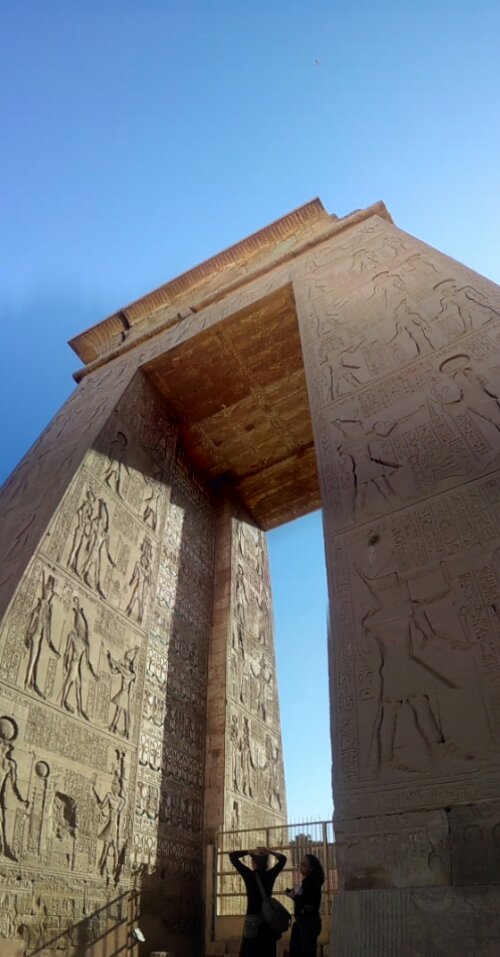
We ate breakfast and Mohammed joined us with a bean dish known as Ful Mudammes – fava beans with spices dished up by some tasty pita bread most likely from the nearby bakery. We drank thick Turkish coffee, ate omelets, cucumbers, fruits, yogurt, breads, honey. It was delicious and the perfect way to start the day – communing with friends, under that blue blue sky.
We had a long journey planned for the day – a tour through the sites on the east bank of the Nile, outside of the city of Luxor: The Colossi of Memnon, Hatshepsut’s Temple, The Valley of the Kings, The Tombs of the Workers, The Temple Medinat Habu. We had a van, a driver, and a guide – a young guy named Hassan who was an Egyptologist who’d studied Egyptian history at the University of Cairo. I imagine that it’s a decent job to have for a while and is seen as an industry that is always hiring. As someone who spent some years in tourist towns, I can attest to the fact that it can be fun.
So we packed up and took off. We generally don’t take tours, nor do we let ourselves get carted around in tourist vans – it feels too separate from the rest of the culture and a bit weird. Tours are for tourists. However, the easy thing with a tour guide, especially when you don’t speak the language and are in a country that is, regardless of it’s general peacefulness, in a state of unrest, and is also possibly headed towards more extreme Islamic politics and, all in all, has that porous fuzzy administrative structure that such countries are known for – the easy thing is that the tour guide can take care of all the ins and outs. He knows where to go, how to get there, who to talk to, and what to say and it all goes smoothly and we can just follow along, watch, learn, take pictures, smile, and absorb.
There’s so much to take in from these places that it’s hard to really give a synopsis. So I’m going to give bullet points and some other notable occurrences along the way.
The Colossi of Memnon

Basically these are two really large and rather destroyed statues of the Pharaoh Amenhotep III and are 3400 years old. The statues have been reassembled from the pieces that remained, presumably in a heap, since it was shattered by an earthquake in 27 BC. The statues guard the entry way to the temple of Amenhotep which is also destroyed though it supposedly covers a greater acreage than Karnak (which is huge). One security guy in a black sweater and a beret guards the guards. Violet wanted to climb them.
From there we headed up the road into the cliffs of the eastern mountains for Hatshepsut’s Temple.

Hatshepsut’s Temple is spectacular. Much of it has been rebuilt and it’s obvious where and how. It’s an impressive structure – wide and low, with a long avenue leading up to it that once was lined with small statutes of sphinx. Tall cliffs rise up behind it making it all the more spectacular. All around it, in the mountains, are the doorways tombs of other past rulers, dug up now by archaeologists and/or tomb robbers. The carvings on the walls in the lower wings are quite remarkable – showing life outside of Egypt, the peoples of other parts of Africa, wars, animals, etc. Many of these still have the original paints and colors on them, preserved under sand as they were at one time. Incidentally, Hatshepsut’s image was defaced throughout the temple after she died and her stepson Thutmose III took the throne. Back then, the only way to censor was to have someone go up with a chisel and just chip away at the face and the cartouche til it was gone.

Next stop: The Valley of the Kings